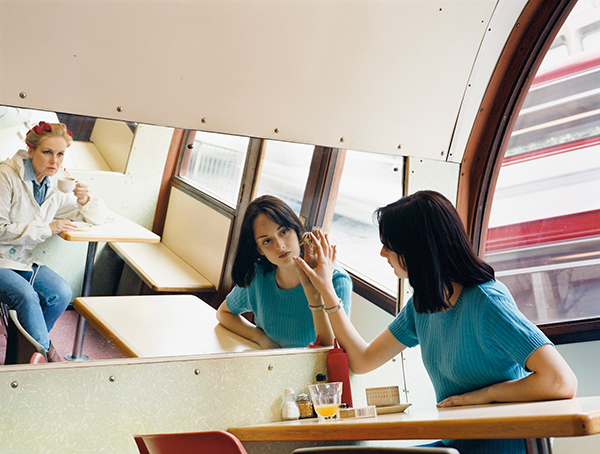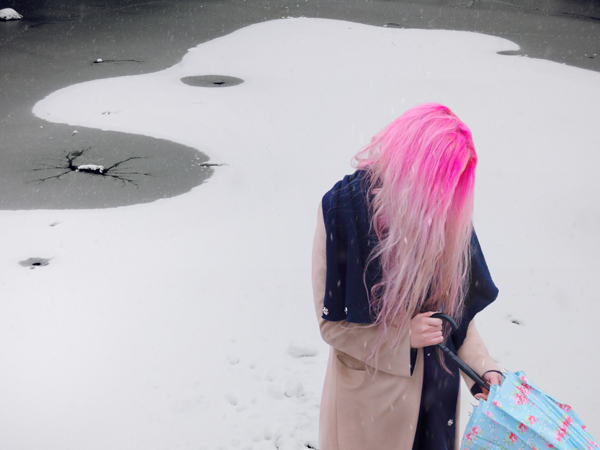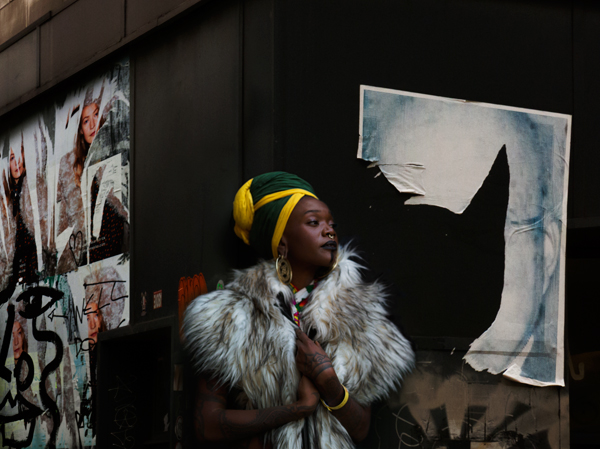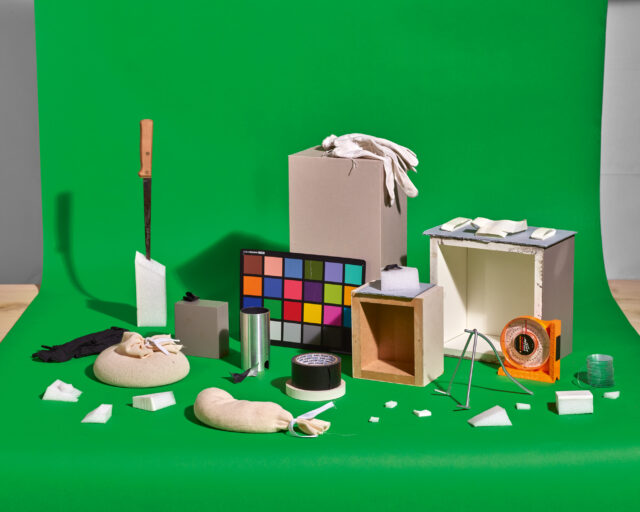Strong Women

Hannah Starkey, Untitled, May 1997, 1997
© the artist and courtesy Maureen Paley, London, and Tanya Bonakdar Gallery, New York
In Hannah Starkey’s recent pictures, London’s East End seems less made up of concrete and steel than conjured from reflections, graphic projections, and the intensity of compressed space and glowing color. The purposefully anonymous women in them—silhouetted by a nightclub marquee, shaded by a shock of pink hair—are integral to the visual world they inhabit. We might see them as images among images, equally resonant of the aspirations and expectations suggested by the city’s surfaces around them, on billboards and hoarding, in shopwindows, or even divined from the hinted-at lives of other city wanderers.

Hannah Starkey, Untitled, January 2013, 2013
© the artist and courtesy Maureen Paley, London, and Tanya Bonakdar Gallery, New York
Starkey has been making singular, large-scale photographs of women in public for over twenty years, since moving to London from her native Belfast. She doesn’t make many pictures, and there are often very long stretches of walking and watching before a handful of new ones takes shape. Often hiring actors or collaborating with friends or strangers, Starkey casts her subjects as anonymous flâneuses, neither specific nor typological. The anticlimactic blankness of their static postures—standing, sitting, staring—and the familiar, transient spaces in which they pause mark them as both actors in the pictures and agents in the world. They might appear to us as posed icons of beauty and desire, but they are also self-aware individuals struggling into formation against the environments—architectural, visual, social—that project and reflect them.

Hannah Starkey, Untitled, November 2015, 2015
© the artist and courtesy Maureen Paley, London, and Tanya Bonakdar Gallery, New York
Despite their sharp stillness, Starkey’s images are incredibly dynamic. Though they’ve often been described as cinematic, their charge comes from the possibilities and surprises only a still image can yield, from the pleasures and challenges of looking carefully at an arrested moment. (To allow your eye to wander freely and completely, her images are best seen at their intended scale, usually around 4 by 5 feet.) In one of Starkey’s earliest photographs, a young woman sits in a café, her hand held up to an oblong mirror. She appears to be admiring her own pretty reflection, but a closer look reveals a moth pinned delicately beneath her fingers. Reflected in the mirror, an older woman in red curlers watches with a faint but unmistakable frown. A more recent image refracts elements from a mosaic of mirrors: architecture, trees, graffiti, pavement, a young woman taking a selfie—and the photographer herself, there with her camera poised. Whatever sleights of hand might be at play—the trick of the angled mirrors, the camera’s perspective, or digital manipulation after the fact—the pieces, again, don’t quite add up. What are we to make of all these apparent signs and symbols? Are they haphazard, coincidental? Do they relate a story, or foretell a future? Or are they performances of seduction?

Hannah Starkey, Untitled, April 2006, 2006
© the artist and courtesy Maureen Paley, London, and Tanya Bonakdar Gallery, New York
For all of Starkey’s suspicion of the negative effects of mass media imagery, particularly of and on women, there’s a joyfulness and an affection for looking and seeing in her pictures. In this spirit, we might detect autobiographical resonances, glints of a shifting mind and eye across the slow accumulation of pictures. This is especially palpable in the more recent work, which thrives on the loose, vibrant mood of the street. There’s a great freedom, after all, a special pleasure of escape in the act of being in public, of watching and being watched. In 1930 Virginia Woolf made up the excuse of buying a pencil as a way of enjoying a solitary walk across London, recounted in her vivid essay “Street Haunting”: “As we step out of the house on a fine evening between four and six, we shed the self our friends know us by and become part of that vast republican army of anonymous trampers, whose society is so agreeable after the solitude of one’s own room.” She returns home with a pencil and the intense emotional energy of other people it might, with great effort and a bit of luck, recollect, reconfigure, and record.
Read more from Aperture Issue 225, “On Feminism,” or subscribe to Aperture and never miss an issue.

























